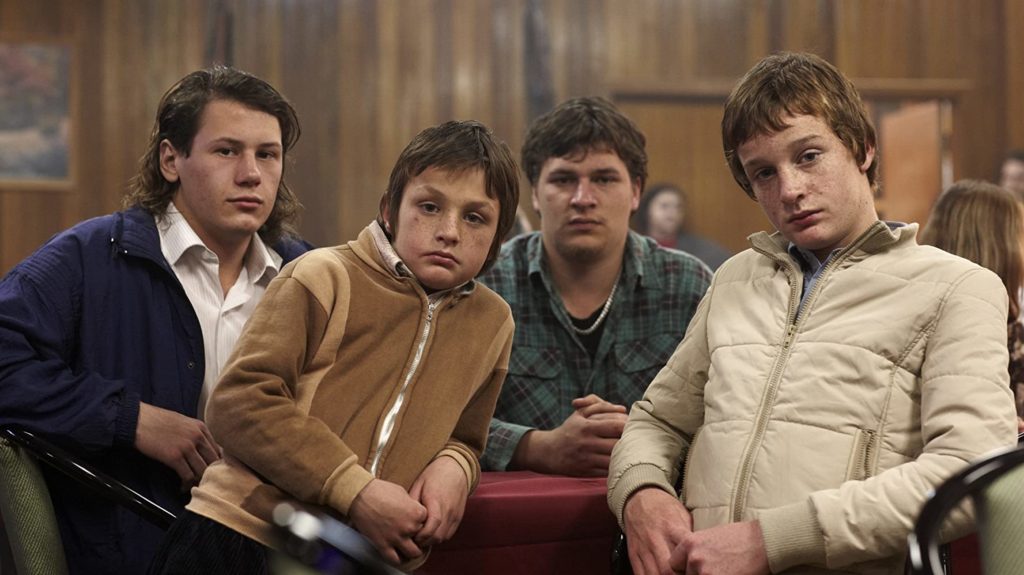
I have often heard it said that violence is the product of fear derived from the lack of understanding. In the case of Justin Kurzel’s film Snowtown (2011), the violence of the protagonists is a direct response to their own inability to understand homosexuality as well as the very nature of their prejudice. One could easily assume that the real cause for the disquieting effect of the film is the real life events on which the film is based. Though the real events are faithfully followed in Snowtown (scripted by Shaun Grant), and these events are in fact disturbingly violent and inhumane, the real terror comes from the sympathetic light in which the film’s murderous protagonists are shown.
The film centers on the relationship between Jamie (Lucas Pittaway) and his father figure John (Daniel Henshall). Jamie lives with his mother and two younger brothers, and has found themselves the victims of their mother’s boyfriend’s penchant for child molestation. When the police fail to act, Jamie’s mother enlists John to harass her old boyfriend and drive him out of town. This incident marks the beginning of John’s relationship with Jamie that is born out of a mutual fear of homosexuality. At first, their reaction to a child molester seems almost appropriate if not excusable. But it is the expansion of that fear which encompasses all homosexuals that is dangerous and unsettling.
The fact that Jamie is himself a victim works to the filmmaker’s advantage, imbuing his character with our sympathies. But we want to resist, and are unable to because John serves as the perfect scapegoat for Jamie’s homophobic behavior, turning Jamie into another form of victim. Still, Jamie does little to resist John’s violent anti-homosexual behavior, and eventually embraces it. Even this is understandable, since it is well established at the outset of Snowtown that Jamie desires as well as requires some kind of father figure.
Soon, Jamie and John have turned their prejudices not only toward homosexuals, but eventually any person of whom John does not approve. As their prejudice grows, so does their appetite for violence, manifesting itself in a series of grizzly homicides. Their “crusade” is not dissimilar to Travis Bickle’s in Taxi Driver (1976), but never assumes the “black & white” perspective that the media imposes onto Bickle’s actions at the end of Taxi Driver. Jamie and John, at only an hour into Snowtown, are met with resistance and fear in their community. Similarly, the Australian media doesn’t glamorize Jamie and John’s actions, instead they condemn them.
The realism of Snowtown is the other defining characteristic that separates the film from its predecessors and makes an easy comparison rather difficult. Taxi Driver had a clear sense of cinematic artifice in its elaborate shot structure and its clear thematic concerns, similarly the more gritty low budget films like Henry: Portrait Of A Serial Killer (1986) could not escape the inherent camp of their own genre and its limitations. Snowtown doesn’t hide behind cinematic convention or even cinematic reinvention. The camera works as an “objective” observer of the film’s action, avoiding sub textual cues and obvious signifiers. Of course the film could never truly be “objective”, but it gives that illusion in much the same way as Harmony Korine’s film Gummo did in 1997. A kinetic camera that navigates the film’s narrative as if it were shooting a documentary is the singular cue given during the entire movie, and creates the “objective” illusion quite easily.
The “objectivity” of Snowtown does more than demystify the serial killer than had been done in Shohei Imamura’s Vengeance Is Mine (1979) or Richard Fleischer’s The Boston Strangler (1968); it creates a palatable atmosphere that recalls the social realist films made in America during the late fifties. The issue of Snowtown is not civil rights or any other of the trappings of the fifties, but rather a study in how society’s inability to accept itself can produce people like John and Jamie. Consider how long it takes for a society to accept all the varying components that make up that society. If one traces Britain’s history of homophobia back to the nineteenth century or further, it becomes quite obvious that though there were always homosexuals, it wasn’t until the late twentieth century that they were remotely accepted. Like Britain, Australia suffers from the same troubled relationship with homosexuality, which results in creating radically violent and conservative personalities such as Jamie and John.
The approach to the serial killer as a byproduct of his society was lightly touched upon as a subtext in Fleischer’s The Boston Strangler. Tony Curtis’ Strangler seems driven by the violence of the early sixties; often Curtis is framed in a shot committing a murder while the television in the background of the shot broadcasts either a civil rights protest or the assassination of President Kennedy. This instance of the killer being surrounded by violence is much more personal for Jamie. Remember, he himself was a victim, molested by his mother’s boyfriend. Later, John introduces him to more violence as they harass the perpetrator of the molestation. This relationship of the killer to his or her’s sociological environment becomes cyclical, as violence begets violence begets violence, etc.These varying components of Snowtown create a larger portrait of violence in general. The intimacy with which director Justin Kurzel depicts violence has a paranoid effect on the audience. The nature of violence as a kind of sociological cotangent in Snowtown becomes an indictment of society as a whole.
